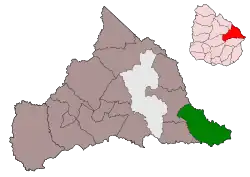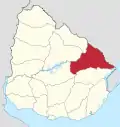Municipality of Río Branco
Municipio de Río Branco | |
|---|---|
| Municipality of Río Branco | |
 Location of the municipality of Río Branco within the department of Cerro Largo and Uruguay. | |
| Coordinates: 32°36′S 53°24′W / 32.6°S 53.4°W | |
| Country | |
| Department | Cerro Largo |
| Founded (as Autonomous Elective Local Board) | 15 December 1960 |
| Conversion to municipality | 13 September 2009 |
| Seat | Río Branco |
| Government | |
| • Mayor | Christian Morel (PN) [1] |
| Area | |
| • Total | 933.2 km2 (360.3 sq mi) |
| Population (2011)[2] | |
| • Total | 16,270 |
| • Density | 17/km2 (45/sq mi) |
| Time zone | UTC-3 |
| Constituencies | GDA, GDB, GDC, GDD and GDH |
| Website | https://www.gub.uy/intendencia-cerro-largo/municipio-rio-branco |
The municipality of Río Branco is one of the municipalities of Cerro Largo Department, Uruguay, established on 13 September 2009. Its seat is the town of Río Branco. It replaced the Autonomous and Elective Local Board of Río Branco established in 1960.
History
The Local Council of Río Branco was established as an Autonomous and Local Elective Board on 15 December 1960, obtaining wider powers than existing standard Local Boards. Until before the Laws of Municipalities were passed in late 2009 and early 2010, it was one of the three existing second level administrative subdivisions, the others being the Local Boards of Bella Unión and San Carlos, that were granted certain level of autonomy and able to hold local elections of its authorities. It included the territory of the Third Judicial Section of Cerro Largo Department.[3] The extent of its powers were the same as those granted by the Law of Departmental Governments of 1935 to the Intendants related to management, wider even compared to the other two Autonomous and Elective Boards and actually almost decentralized from the Departmental Government.
In September 2009, by the provision of the Law of Municipalities No. 18567 of 2009, it was converted to Municipality (that ordered the creation of municipalities in all settlements with a population of at least 2000 inhabitants), with the powers of the new system but also keeping the powers obtained from the former system. It also kept the same territorial jurisdiction of the Autonomous and Elective Local Board of Río Branco and includes the constituencies identified by the series GDA, GDB, GDC, GDD and GDH as defined by the Electoral Board of Cerro Largo.[4][5][6]
Location
The municipality is located at the south east side of Cerro Largo Department. It borders Brazil's Rio Grande do Sul State to the north, the Lagoon Merín to the east, Treinta y Tres Department to the south, Plácido Rosas municipality to the south west and Las Cañas municipality to the north west.
It includes a vast country region mainly destined to rice paddies and, to a lesser extent, used for livestock. It also features flood-prone low plains, due to the Yaguarón and Tacuarí Rivers, and the Lagoon Merín.[7]
Settlements
The following ones are part of this municipality:
- Río Branco (seat)
- Lago Merín (resort)
- Uruguay (town)
- Getulio Vargas (town)
Authorities
The authority of the municipality is the Municipal Council, integrated by the Mayor (who presides it) and four Councilors. The following is the list of authorities since 2010.
| N° | Mayor | Party | Start | End | Notes |
|---|---|---|---|---|---|
| 1 | Robert Pereyra | Colorado Party | July 2010 | July 2015 | Elected Mayor.[8] Councilors: Amadea Ledesma (PC), Darío Barboza (PC), Mauro L. Suárez (PN), Ángel Soca (FA).[8] |
| 2 | Christian Morel | National Party | July 2015 | November 2020 | Elected Mayor.[9][10] Councilors: José López (PN), Marcos López (PN), Dardo Rodríguez (PN), Yamila Bondad (FA).[9] |
| 3 | Christian Morel | National Party | November 2020 | Incumbent | Reelected Mayor.[11][12] Councilors: Federico López (PN), Rosa Espíndola (PN), Alex Reyes (PN), Marcos Acuña (PN).[11] |
References
- ↑ "Alcaldes y Alcaldesas asumieron en los 125 Municipios de Uruguay" (in Spanish). Office of Planning and Budget. 30 November 2020. Retrieved 17 August 2021.
- ↑ "Río Branco" (in Spanish). Uruguay Territory Observatory, Office of Planning and Budget. Retrieved 17 August 2021.
- ↑ "Ley N° 12809. DECLARACION DE AUTONOMIA DEL CONCEJO LOCAL DE RIO BRANCO. CERRO LARGO" (in Spanish). IMPO. Retrieved 17 August 2021.
- ↑ "Diario de Sesiones de la Asamblea General, Primer período ordinario de la XLVIIa legislatura, 4ª sesión" (in Spanish). Parliament of Uruguay. 11 March 2010. Archived from the original on 4 March 2016. Retrieved 17 August 2021.
- ↑ "Ley N° 18567. Determínase un nuevo régimen para la descentralización en materia departamental y local y participación ciudadana [original text]" (in Spanish). IMPO. Retrieved 17 August 2021.
- ↑ "Ley N° 18653. CREACION DE MUNICIPIOS EN LOS DEPARTAMENTOS QUE SE DETERMINAN" (in Spanish). IMPO. Retrieved 17 August 2021.
- ↑ Schelotto, Salvador; Abreu, Patricia (16 December 2012). "Territorio y municipios en el Uruguay". Arquisur Revista. 2 (2): 52–71. doi:10.14409/ar.v1i2.932. hdl:20.500.12008/27080. ISSN 1853-2365.
- 1 2 González Arias, Daniel (2011). "Cerro Largo: El PN y los otros en las elecciones departamentales y municipales de Cerro Largo". In Cardarello, Antonio; Magri, Altaïr (eds.). Cambios, certezas e incertidumbres. Elecciones Departamentales y Municipales 2010 (PDF) (in Spanish). Montevideo: Politic Science Institute, School of Social Sciences, University of the Republic. pp. 153–166. ISBN 978-9974-8068-9-4. Archived from the original (PDF) on 10 December 2013.
- 1 2 Pérez, Mauro; Pose, Nicolás (2017). "Cerro Largo: Tras el desafío, la reafirmación nacionalista". In Cardarello, Antonio; Freigedo, Martín (eds.). Los desafíos de un cambio. Elecciones Departamentales y Municipales 2015 (PDF) (in Spanish) (First ed.). Montevideo: School of Social Sciences, University of the Republic. pp. 181–201. ISBN 978-9974-0-1438-1. Archived from the original (PDF) on 6 August 2021 – via Colibri repository.
- ↑ "Quiénes son los 112 alcaldes del país" (in Spanish). Portal 180. 11 May 2015. Retrieved 17 August 2021.
- 1 2 "Listado de Alcaldes y Concejales 2020-2025" (in Spanish). Electoral Court of Uruguay. Archived from the original on 3 August 2021. Retrieved 17 August 2021.
- ↑ "Christian Morel regresa a Río Branco para ser Alcalde de la tercera sección". La Voz de Melo (in Spanish). Melo. 17 November 2020. Retrieved 17 August 2021.
